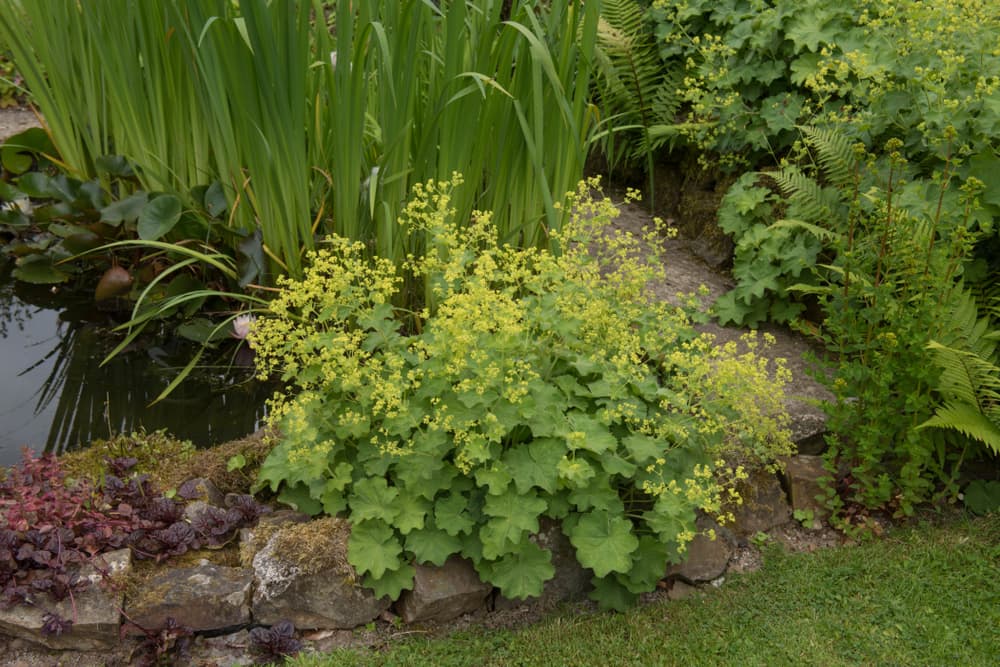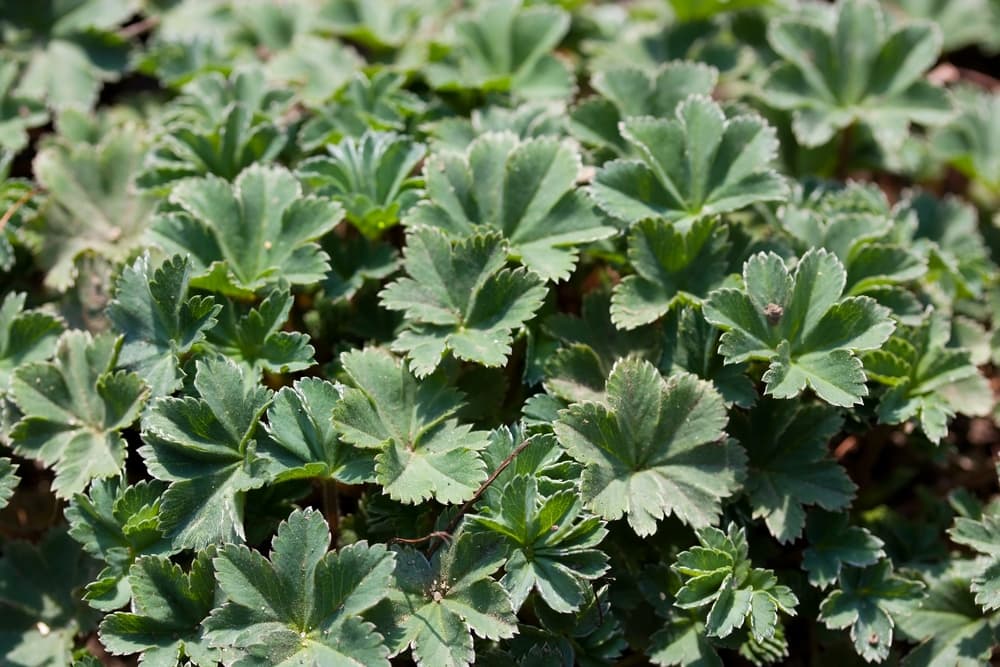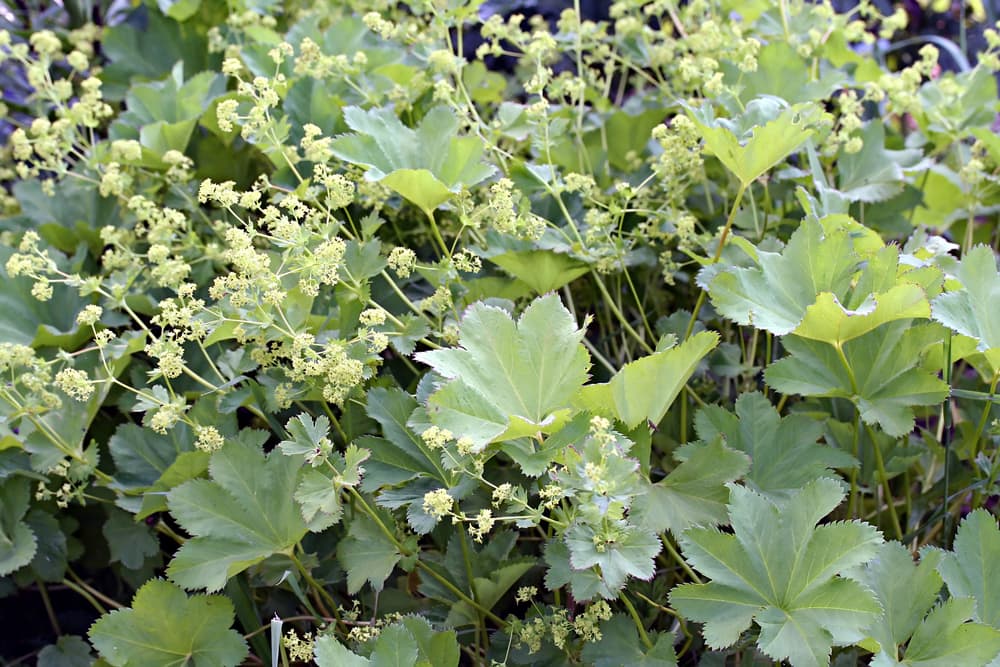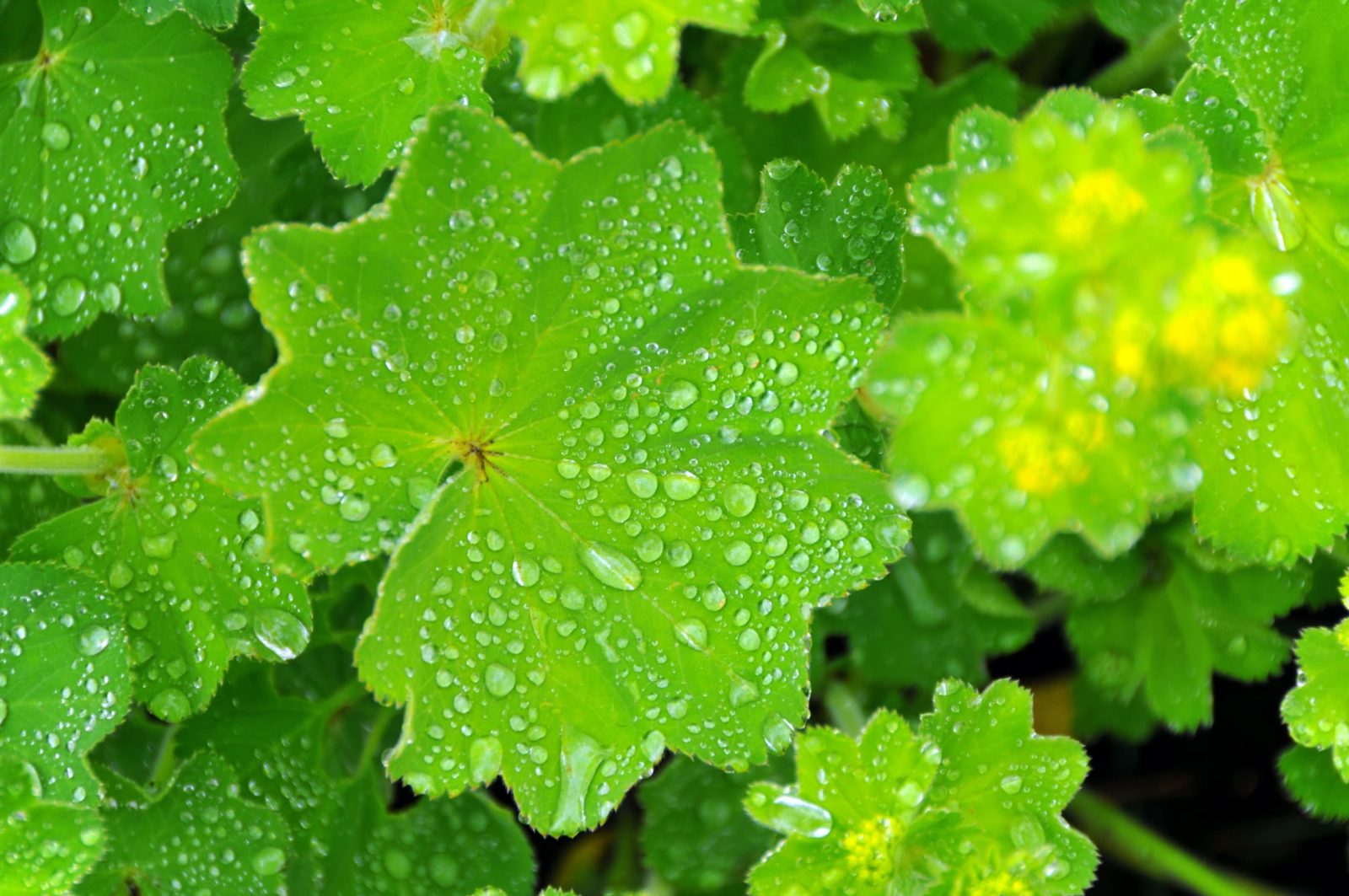PERENNIALS > ALCHEMILLA
Reviewed By COLIN SKELLY

Colin is a Horticulturist and Horticultural Consultant with experience in a range of practical and managerial roles across heritage, commercial and public horticulture. He holds the Royal Horticultural Society’s Master of Horticulture award and has a particular interest in horticultural ecology and naturalistic planting for habitat and climate resilience.
IN THIS GUIDE
ALCHEMILLA GUIDES
Alchemilla, commonly called Lady’s Mantle, is a perennial.
The Alchemilla genus occurs across every continent and consists of 757 species, but Alchemilla mollis is found mainly in the temperate and montane zones of Europe and Asia, ranging from Finland down to Turkey.1Alchemilla L. (n.d.). Kew Royal Botanic Gardens. Retrieved April 4, 2023, from https://powo.science.kew.org/taxon/urn:lsid:ipni.org:names:30008181-2#children
These herbaceous plants occur in clumps and have compound leaves that are lobed or divided, with serrated edges.
Come summer, clusters of tiny polysepalous flowers (where sepals are free from the flower) make a demure appearance.
Overview
| Botanical Name | Alchemilla mollis |
| Common Name(s) | Lady’s Mantle |
| Plant Type | Perennial Flower |
| Native Area | Europe, Asia |
| Hardiness Rating | H7 |
| Foliage | Palmately lobed basal leaves |
| Flowers | Sprays of tiny yellow / green flowers |
| When To Sow | March, April, May |
| Flowering Months | July, August, September |
Sunlight
Preferred
Full Sun / Partial Shade
Exposure
Exposed or Sheltered
Size
Height
0.1 – 0.5M
Spread
0.1 – 0.5M
Bloom Time
July – September
Soil
Preferred
Most Soil Types
Moisture
Moist but well drained
pH
Any
Curiously, this humble plant belongs to the same Botanical family, Rosaceae, as does the most popular plant of all: the much-feted rose.2Cullen, J. (2005). Alchemilla Speciosa. Curtis’s Botanical Magazine, 23(1), 37–42. https://www.jstor.org/stable/45065731
Other genera of this family include almost all the berries plus peaches, pears, apricots, plums, and more, so Lady’s Mantle is the poor country cousin among its distinguished family’s members.

Unlike most garden plants, Alchemilla does not have stems, but, has rhizomes.3S. (n.d.-b). Lady’s Mantle. Wisconsin Horticulture. Retrieved March 9, 2023, from https://hort.extension.wisc.edu/articles/ladys-mantle-alchemilla-mollis/
These are underground or sub-soil stems, not to be mistaken for roots, that connect the surface shoots and the root system of the plant.
The significance of rhizomes is that they play a part in plant reproduction, and, hence, is a botanical fact of value to the gardener.

This little plant’s small flowers have no (proper) petals and are comprised only of sepals whose colour ranges from yellow through lime green to chartreuse depending on the species.
Most Alchemilla species are super-hydrophobic or super-water-repellent.
This quirk of Lady’s Mantle brings about its special charm: coruscant, dew-like water droplets coating its leaves.
How To Grow Alchemilla
First, the good news – and the bad news.
If you already have some or another Alchemilla plants, you will not need to grow those, for Alchemilla self-seed aggressively and thereby also ‘self-grow’.
Indeed, they do so to the point of becoming invasive during prime season.
You can propagate Lady’s Mantle from seeds or seedlings, or by division, also called separation.
Growing From Seed
Seeds can be sown indoors in pots or directly in the chosen spot in your garden.
If sowing outdoors, do so in early spring after any possibility of frost.

Sow seeds 12-15 inches apart, cover with a sprinkling of soil, and water regularly and well.
It will take 3-4 weeks for the seeds to germinate.
If sowing indoors in pots, do so one-and-a-half to two months before your projected transplant date which should be after spring’s last frost.
Transplant when A. mollis and/or similar species have grown to about four inches.

Ideally the soil should be rich, moist and humus-based.
Any potted seedlings acquired from a friend or a nursery may be transplanted using the same guidelines as above.
Division
Alchemilla are easy to divide or separate because of the thick sub-soil rhizomes and laterally-traversing root systems.
Divide the plants in spring or end of summer, before or after flowering season.

Plant Care & Growing Tips
Lady’s Mantle is not at all fussy and requires but little care and attention.
Most species do not tolerate droughty conditions so ensure that your plants do not sit in dried-out soil for any great length of time.
Sunlight
They thrive in any and all light from more than half shade up to full sun; however, most species need to be protected from full sun during a hot summer.
In such weather, make sure to regularly water your plants and give them midday shade.
Soil
Alchemilla varieties grow well in most any soil – be it chalky, loamy, clayey or even sandy – so long as the soil is kept moist (but not wet) and well drained.
Alchemilla does best in soils of pH 5.5 and 7.5. Measure your soil’s pH value and, if necessary, acidify or alkalinise.

Add humus to the soil, especially in dry or hot climates.
Though fertiliser is superfluous, if your Alchemilla are not thriving use slow-release organic fertiliser in spring.
It takes two years or more from germination for Alchemilla to bloom, so, no matter how much you may pamper seedlings and young plants, do be patient.
Deadheading
Alchemilla is one of those uncommon plants for which an ‘anti-growing’ tip is called for.
They self-seed to the extent of running riot and even becoming an invasive species.
To keep this trait in check, move fast to deadhead spent flower stalks.
Pruning Alchemilla
Pruning as such is not necessary for Alchemilla.
What you could do is to deadhead withered flower stalks and you may be rewarded with a second flush in late summer.

If Alchemilla foliage or flowers appear worn or untidy, cut back the stalks to ground level right after the flowering season is over, and new growth will start to sprout.
Colin Skelly recommends: “I cut back Alchemilla mollis plants to the ground as they tend to look untidy as summer progresses, especially after prolonged dry weather.
“When they reappear they look much fresher and will look tidier going into the autumn.”
You can obtain fresh growth at any time during the season by cutting back the plant.
As most Alchemilla species self-propagate quite rapidly, you may get undesired seedlings in stray parts of your garden.
If so, uproot them early.
Alchemilla Varieties
A. ellenbeckii is at the lower extreme in height, growing to only about two inches. Its silver-edged leaves are less than an inch in width.

The Dwarf Lady’s Mantle of Eastern Europe is also at the short end of the scale, growing to only half-a-foot. With its clumps of palmate leaves, it is often used as groundcover.

At the higher extreme is A. mollis ‘Robusta’ type which grows to two feet tall and also two feet wide.
Perhaps A. conjuncta combines the best qualities of the species.

It is hardy in severe and wintry climates, attains a height of about one foot even, bears lime-to-chartreuse flowers, and an attractive silver edging adorns its leaves.
Finally, this is one Alchemilla that is not an aggressive self-seeder and, so, it will not try to conquer your garden!
Besides borders and edges, Lady’s Mantle are often used in cottage gardens and rock gardens.
Where Alchemilla is concerned, be imaginative! For example, you can make sharp use of a short or dwarf species to edge and line your walkway or driveway.
Common Problems
Alchemilla is generally not prone to diseases and is pest-resistant (which are indicators of its healing qualities).
For these reasons too it is a low-maintenance plant.
The only problems to watch out for are scorching and fungus.

During sunny and hot summer days, protect the plant by giving it shade.
Fungus may attack the plant in very humid conditions and particularly so if the crown remains damp.
While deer and rabbits give Alchemilla a pass, cattle, sheep, and horses will happily chomp on most species so if you live in the countryside or in farmland, watch out for the mantle-munching ruminants.
References
- 1Alchemilla L. (n.d.). Kew Royal Botanic Gardens. Retrieved April 4, 2023, from https://powo.science.kew.org/taxon/urn:lsid:ipni.org:names:30008181-2#children
- 2Cullen, J. (2005). Alchemilla Speciosa. Curtis’s Botanical Magazine, 23(1), 37–42. https://www.jstor.org/stable/45065731
- 3S. (n.d.-b). Lady’s Mantle. Wisconsin Horticulture. Retrieved March 9, 2023, from https://hort.extension.wisc.edu/articles/ladys-mantle-alchemilla-mollis/


